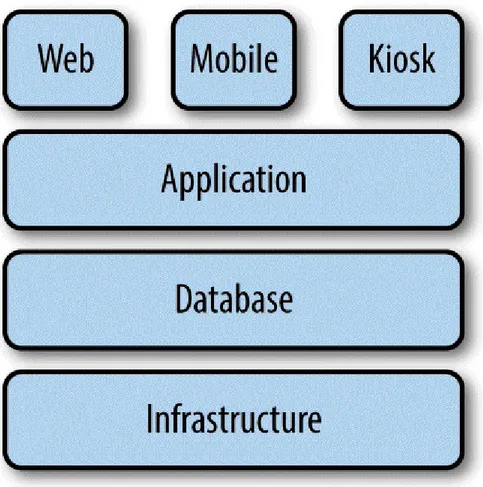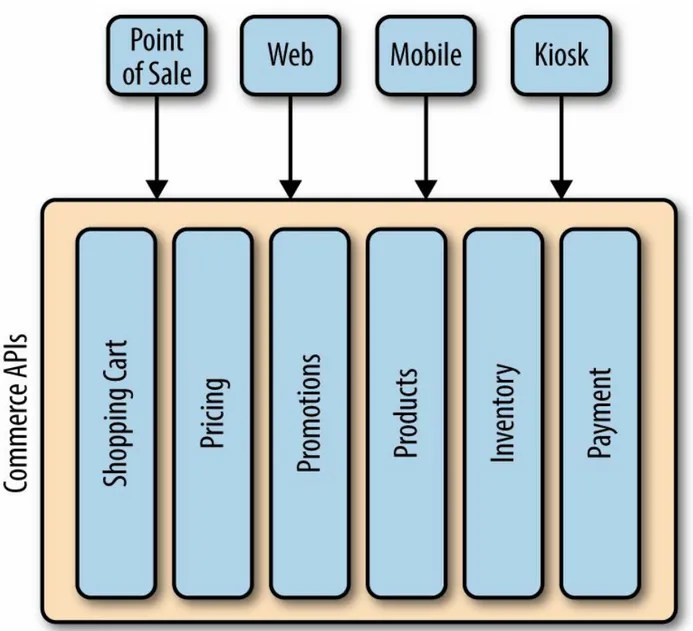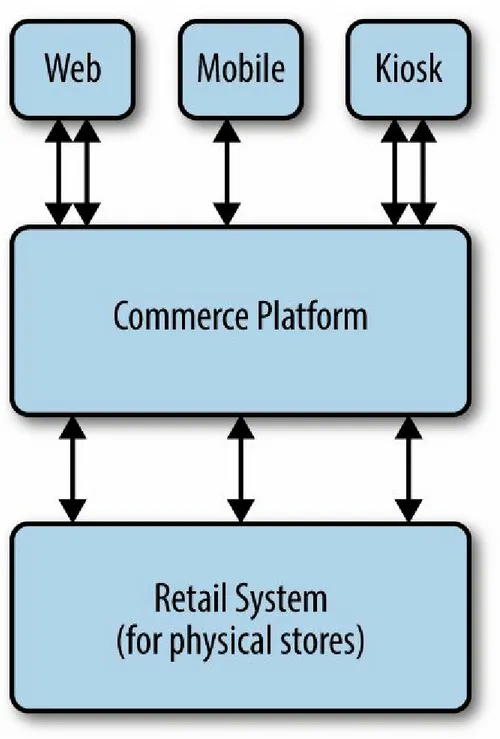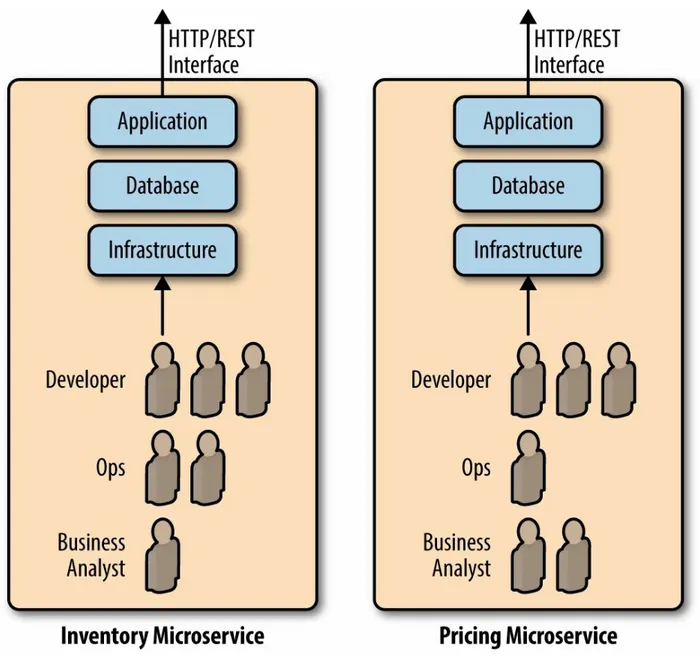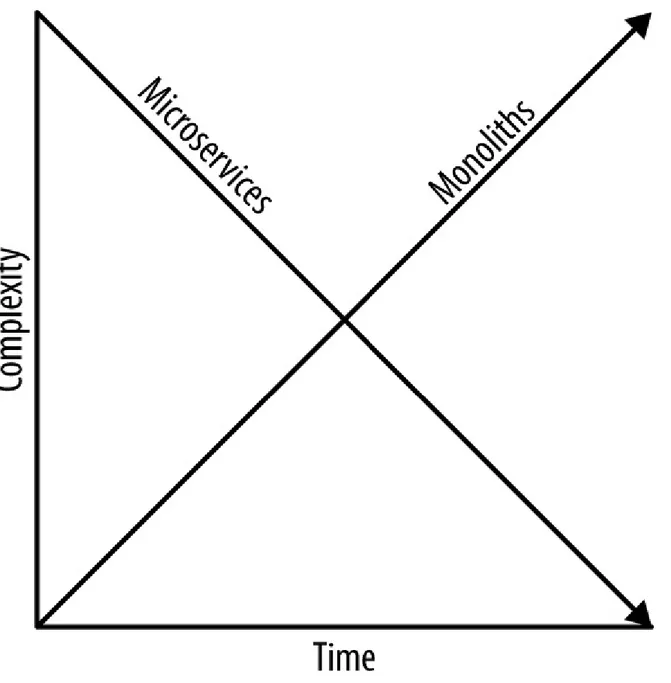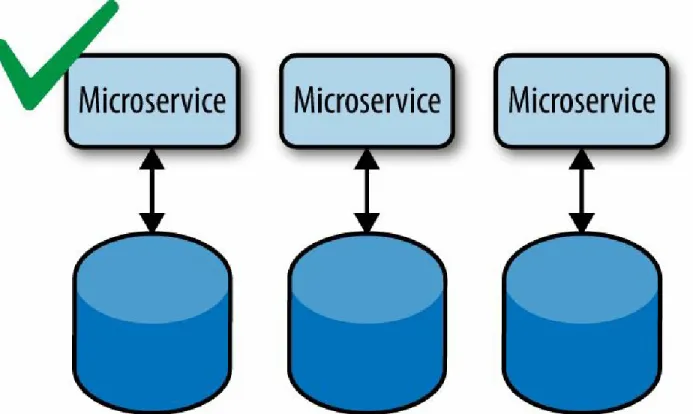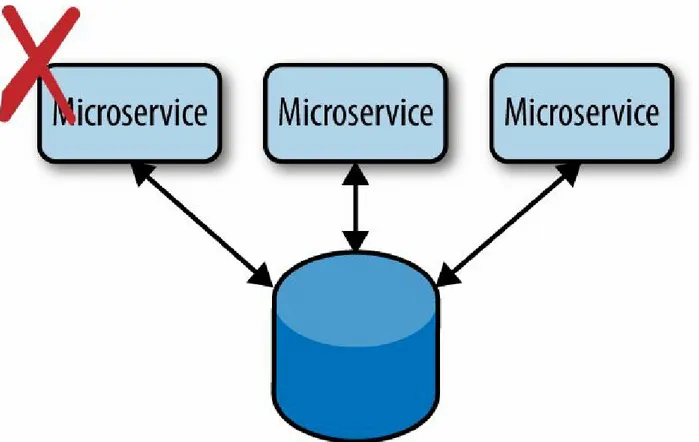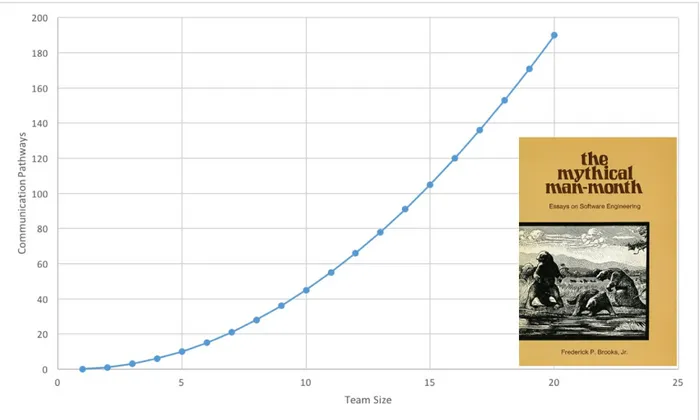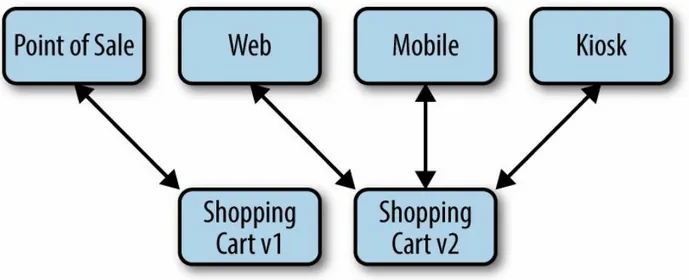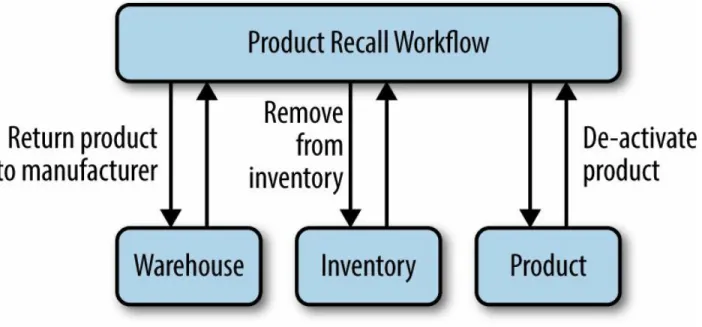Microservices for Modern
Commerce
Dramatically Increase Development Velocity by Applying Microservices to Commerce
Microservices for Modern Commerce by Kelly Goetsch
Copyright © 2017 O’Reilly Media. All rights reserved. Printed in the United States of America.
Published by O’Reilly Media, Inc., 1005 Gravenstein Highway North, Sebastopol, CA 95472.
O’Reilly books may be purchased for educational, business, or sales promotional use. Online editions are also available for most titles (http://oreilly.com/safari). For more information, contact our corporate/institutional sales department: 800-998-9938 or
Editors: Nan Barber and Brian Foster
Production Editor: Kristen Brown
Copyeditor: Octal Publishing, Inc.
Interior Designer: David Futato
Cover Designer: Karen Montgomery
Illustrator: Rebecca Demarest
Technical Reviewers: Sachin Pikle, Tony Moores, Oleg Ilyenko, and Christoph Neijenhuis
Revision History for the First Edition 2016-10-26: First Release
2017-01-06: Second Release
The O’Reilly logo is a registered trademark of O’Reilly Media, Inc.
Microservices for Modern Commerce, the cover image, and related trade dress are trademarks of O’Reilly Media, Inc.
While the publisher and the author have used good faith efforts to ensure that the information and instructions contained in this work are accurate, the publisher and the author disclaim all responsibility for errors or omissions, including without limitation responsibility for damages resulting from the use of or reliance on this work. Use of the information and instructions contained in this work is at your own risk. If any code samples or other technology this work contains or describes is subject to open source licenses or the
intellectual property rights of others, it is your responsibility to ensure that your use thereof complies with such licenses and/or rights.
Foreword
We at Rewe Group, a 90-year–old international retailer with €52 billion in revenue across 40 brands with more than 12,000 physical stores, are in the midst of an end-to-end digital transformation of our entire business. Our competitors today are technology companies — not other retailers. Innovation through technology is now at the very core of our business. Technology is what gets the right product to the right person, at the right time.
I have long believed that the role of the Chief Executive Officer and Chief Product Officer would merge, as organizations shift focus to a
product-oriented mindset. Most CEOs agreed with me but have found it impossible to accomplish because of the legacy enterprise technology that powers business, particularly retail. It is not possible to run an agile business in today’s world while running technology that was developed in the 1990’s for a different era. Quarterly releases to production are no longer acceptable. Instead, releases to production must occur multiple times a day. It’s taken 15 years for a new approach to surface; that new approach is microservices.
Microservices are central to our new approach to commerce. We now draw from an infinite pool of engineering talent across Europe to build hundreds of microservices, all in parallel. The value of microservices to us is innovation. We can quickly assemble teams. Once established, each team can then iterate on a new feature in production over the course of hours rather than the
months or even years it would have taken us using the traditional approach. Today’s infrastructure is all public cloud-based, which offers limitless
elasticity. Teams are now owners of products, with all of the tools required to autonomously innovate.
Microservices has been transformational to our business in many ways and we will continue to make deep investments as we transform to be the market leader.
Jean-Jacques van Oosten
Changing Consumer Demands
We are entering a new era in commerce. Consumers demand to seamlessly transact anywhere, anytime, on any client. Every sale is the culmination of potentially dozens of interactions with a consumer. Today, smartphones alone influence 84% of millennials’ purchases. Digital touchpoints influence 56% of all purchases. Selling something to an end consumer is far more
complicated than it used to be, even just 10 years ago. Consumers are firmly in charge and expect to make purchases on their terms.
A Brand Experience — Not Simply a Transaction
Those engaged in commerce are surviving and thriving in today’s era of commoditized goods by creating experiences, often through the use of content. Consumers want a story behind the product they’re buying. A product is never just a product — it’s a reflection of the consumer. It’s a statement. Today’s brands are successful because they are able to
Consistency of Experience Across Channels
Consumers no longer see divisions between channels (point of sale, web, mobile, kiosk, etc.). Consumers expect to see the same inventory levels,
Value-Added Features
Convenience
Barely a hundred years ago, physical retail stores were the only way to make a purchase. Then, catalogs came of age. In the late 1990s, the Internet began to take off, and consumers could purchase through a website. Later,
Retailers (and Everyone Else) Are Now Powered by
Software
Technology permeates every sector of the economy, even those not formally classified as high-tech. These days every company is a tech company.
The New York Times
The increased demands from consumers have forced retailers to turn into software companies who happen to be in the business of selling physical or virtual products. Every aspect of a retailer runs on software — from product placement on shelves, to the robots that power warehouses, to the app that runs on the latest Apple Watch.
Software not only saves money by improving efficiency, it can drive top-line growth by enabling marketers to build successful brands. Consumers want an
experience — not simply to buy a commoditized product. Marketers can use technology to form life-long bonds with end consumers by matching the right content to the right consumer.
The Status Quo Is Too Slow
Most enterprises with $100 million per year in online revenue release code to production too slowly. Releases often occur once each quarter and require an evening of downtime. Often, the entire team must come in over a weekend. Enterprises are still learning how to reorient themselves around software. It wasn’t too long ago that commerce was seen as an IT-only expense, out on the periphery of an organization.
IT Is Seen as an Expense to be Minimized
Organization Structure
Any organization that designs a system (defined broadly) will produce a design whose structure is a copy of the organization’s communication structure.
Mel Conway (1968)
Conway’s famous observation in his seminal paper has been so crucial to microservices that microservices is often called “Hacking Conway’s Law.” Most IT organizations are set up to minimize cost through specialization (see Figure 1-1). Storage administrators are in their own group, Java developers are in their own group, and so on. This allows each person to be fairly efficient, but the system as a whole is slower.
Each team has its own work location, process for receiving work (typically a ticketing system of some sort), service level agreements, process for
assigning work to individuals, release cycles, and so on. This strict separation makes it difficult to make any changes that span multiple teams. For
example, suppose that a Java developer receives a requirement to begin capturing a customer’s shoe size during registration. In a typical enterprise, this would be incredibly difficult even though the work should take about two minutes for any competent developer to perform. Here’s a non-exhaustive list of the serial steps required to perform this:
1. Java developer receives requirement
2. Java developer must use DBA’s ticketing system to file a ticket
3. DBA team receives work order, prioritizes it, and assigns it
4. DBA adds column to database per work order
5. DBA updates ticket, requesting that the Java developer view that it was added correctly
6. Java developer logs in to database and finds that it was added correctly
7. Java developer updates ticket stating that the column was added correctly and that the change can be promoted
8. Java developer waits for next database build
9. Java developer updates the object relational mapping system to look for the new column in the database
10. Java developer updates the registration API to include birth date
Coupling
Today’s enterprises are characterized by extreme coupling, both in terms of organization and architecture.
Let’s begin with organization.
Enterprises cause extremely tight coupling between horizontal layers because they build teams of people who have only one focus. For example, each user interface (point of sale, web, mobile, kiosk, etc.) has its own team. Those UIs are tightly coupled to one or more applications, which are each owned by a separate team. Often, there’s an integration team that glues together the different applications. Then, there’s a database on which all teams are
completely dependent. Infrastructure is managed by yet another team. Each team, no doubt, is good at what they do. But those barriers cause tight
coupling between teams, which introduces communication overhead and causes delays.
It would be as if an auto repair shop had one person to order tires, another person to unscrew the lug nuts, another person to remove the old tire, another person to balance the new tire, another person to mount it, and one final person to screw on the lug nuts. Sure, each of those six people are the best at what they do but the overhead of coordinating those activities across six people far outweighs any gains had by the efficiency improvement at each step. Yet this is how enterprises operate today. In the past, this was necessary because these layers all required extensive expertise. For example,
networking required decades of experience and real competency. Now it’s all software-based, as illustrated here:
$ docker network create frontend-network
To further complicate matters, enterprises encourage too much code sharing. Because IT is seen as a cost, and code is expensive to develop, many
savings. Every team that this library is forced on now has a firm dependency on the team that created the OAuth client. There is now a tight coupling between teams where one didn’t exist before. A typical enterprise application could have hundreds of shared libraries, creating a web of dependencies. Over time, this complex labyrinth devolves into paralysis; everyone is afraid to touch anything because it could break the entire system.
Architecture introduces even more coupling. Enterprises have a handful of large, monolithic applications such as ERP, CRM, WMS, OMS, CMS, and so on. These large monolithic applications often expose many different
endpoints, but those endpoints are often not independently consumable. The endpoints must be called in a specific order and fed specific data. That’s why these monolithic applications are glued together by the use of enterprise service buses, with a lot of business logic residing in those buses. This tight coupling of large monolithic applications results in testing and releasing all monolithic applications together as an atomic unit. Changing one endpoint in one monolithic can have wide-ranging consequences across many of the other monolithic applications that might be consuming it.
Yet one more way of coupling is the practice of releasing only one version of an application to production at any time. Suppose that a company deploys version 3.2 of a monolithic commerce application to production. The website, iOS, Android, kiosk, and chatbot clients have all coded to version 3.2 of that application. What happens when the company deploys version 4 of the
commerce application? It’s going to break all of the clients that have coded to version 3.2. With only one version of an application deployed, you must update your monolith and all clients at the same time, which is coupling at its most extreme.
Packaged Applications
Many of today’s enterprise applications are large, monolithic packaged applications that are bought from a handful of large software vendors, deployed on-premises, and heavily customized. Many packaged commerce applications have millions of lines of customized code.
(Real) Omnichannel Is the Future
Omnichannel is the future of retail. Today’s top leaders have mastered it, but the vast majority of retailers have yet to adopt it.
To end consumers, omnichannel means having a consistent experience with a brand, regardless of how they interact with it. Whether through a website, mobile device, wearable device, or in store, the experience is the same and integrated.
The web is dead. Long live the Internet.
Chris Anderson and Michael Wolff , August 17 , 2010
This is why many in the industry have dropped “e” from “eCommerce” to reflect that it’s not something different. Consumers should be able to buy online and pick up or return in-store, browse in-store and buy online, have access to the same promotions, and so on. If channels are offering different data (subset of products, different prices, etc.) it should be because the experience is being optimized for each channel or there are opportunities to price discriminate.
Figure 1-2. True omnichannel — single systems of record for each business function; disposable UIs
Again, the experience per channel can vary, but the variations are deliberate rather than as a result of IT fragmentation.
Most of today’s enterprise commerce platforms are sidecars on top of the old in-store retail platforms. There might be additional sidecars on top of the commerce platforms for other channels, such as mobile. Each of these
systems acts as its own mini system of record, with heavy integration back to the old in-store retail platform, as shown in Figure 1-3.
and so on, which might or might not ever be reconciled with the eventual system of record. For example, many retailers have web-only pricing, promotions, products, inventory, and so forth.
Figure 1-3. Typical commerce application — large monolithic applications tightly coupled with legacy backend systems of record (ERP, CRM, etc.)
website. But now, there are dozens if not hundreds of channels. The old approach just doesn’t scale anymore. As a thought experiment, could you deploy Amazon.com as a single monolithic application as one large EAR file? No. It’s ludicrous to think about it. But retailers trying to unseat
Origins of Microservices
Although the term “Microservices” first rose to prominence in 2013, the concepts have been with us for decades.
1. Make each program do one thing well. To do a new job, build afresh rather than complicate old programs by adding new features.
2. Expect the output of every program to become the input to another, as yet unknown, program. Don’t clutter output with extraneous information. Avoid stringently columnar or binary input formats. Don’t insist on interactive input.
3. Design and build software, even operating systems, to be tried early, ideally within weeks. Don’t hesitate to throw away the clumsy parts and rebuild them.
Doug McIlroy, one of the founders of Unix and inventor of the Unix pipe, 1978
The software industry has long looked for ways to break up large monolithic applications into smaller more modular pieces with the goal of reducing complexity. From Unix pipes to dynamic-link libraries (DLLs) to object-oriented programming to service-object-oriented architecture (SOA), there have been many attempts.
It is only due to advances in computer science theory, organizational theory, software development methodology, and infrastructure that microservices has emerged as a credible alternative to building applications.
Introducing Microservices
Microservices are individual pieces of business functionality that are
Inner versus Outer Complexity
Fundamentally, microservices shift complexity outward, trading external complexity for inner simplicity. “Inner” is what’s in a single microservice and how it’s packaged. It includes the runtime, the business logic, coding to the datastore, circuit breakers, management of application state, and so on — basically, anything for which an individual developer is responsible. “Outer” is everything outside of the individual microservice, including how instances of the application are deployed, how individual instances are
discovered/routed to, load balancers, messaging, networking — basically anything for which an ops person outside of an individual microservice team is responsible.
Monolithic applications have always been difficult to build, especially as they increase in size. But monoliths are relatively easy to deploy and manage. With microservices, each microservice is exceedingly easy to build and manage because the application is small and limited in scope. Large
monolithic applications can have tens of millions of lines of code whereas a microservice may only have a few thousand. Some of the more extreme microservices practitioners say that a microservice should be so small that it can be completely rewritten over a weekend. However, although each
microservice is easier to build, deploy, and manage, the outer complexity becomes more difficult.
There is no single development, in either technology or management technique, which by itself promises even one order of magnitude [tenfold] improvement within a decade in productivity, in reliability, in simplicity. Fred Brooks, 1986
Microservices is worth the tradeoff from inner to outer complexity, especially for commerce, because it dramatically shortens the time to market for new individual features. Because each team is isolated, a requirement can often be implemented and deployed to production within the course of an hour. This is possible because the scope of each team’s work is limited to its own
in complexity with each passing year as they get larger. Over time, this dramatically slows down development due to the complexity of the monolithic applications.
Defining Microservices
Now that we’ve reviewed some of the high-level characteristics of
microservices, let’s look at what the defining characteristics actually are:
Single purpose
Do one thing and do it well.
Encapsulation
Each microservice owns its own data. Interaction with the world is through well-defined APIs (often, but not always, HTTP REST).
Ownership
A single team of 2 to 15 (7, plus or minus 2, is the standard) people develop, deploy and manage a single microservice through its lifecycle.
Autonomy
Each team is able to build and deploy its own microservice at any time for any reason, without having to coordinate with anyone else. Each team also has a lot of freedom in making its own implementation decisions.
Multiple versions
Multiple versions of each microservice can exist in the same environment at the same time.
Choreography
Actions across multiple microservices are managed in a distributed fashion, with each endpoint being intelligent enough to know its inputs and outputs. There is not a top-down workflow that manages a
transaction across multiple microservice boundaries.
Eventual consistency
NOTE
It’s tempting to think of microservices versus monoliths, but there’s a lot of gray area between the two. There are very few “true” adherents to all of the principles of microservices. What is outlined here is more of a textbook definition. Feel free to implement only what works for you and your organization. Don’t get too dogmatic.
Let’s explore each of these in more depth.
Single purpose
A large monolithic application can have tens of millions of lines of code and perform hundreds of individual business functions. For example, one
application might contain code to handle products, inventory, prices,
promotions, shopping carts, orders, profiles, and so on. Microservices, on the other hand, each perform exactly one business function. Going back to the founding principles of Unix, Write programs that do one thing and do it well, is a defining characteristic of microservices. Doing one thing well allows the teams to stay focused and for the complexity to stay at a minimum.
It is only natural that applications accrue more and more functionality over time. What begins as a 2,000-line microservice can evolve to one comprising more than 10,000 lines as a team builds competency and the business
evolves. The size of the codebase isn’t as important as the size of the team responsible for that microservice. Because many of the benefits of
microservices come from working together as a small tight-knit team (2 to 15 people). If the number of people working on a microservice exceeds 15, that microservice is probably trying to do too many things and should be broken up.
In addition to team size, another quick test is to look at the name of a
microservice. The name of a microservice should precisely describe what it does. A microservice should be named “Pricing” or “Inventory” — not “PricingAndInventory.”
Encapsulation
should have its own datastore, cache store, storage volume, and so forth (see Figure 2-3). No other microservice or system should ever bypass a
microservice’s API and write directly to a datastore, cache layer, file system, or anything else. A microservices’ only interaction with the world should be through a clearly defined API.
Figure 2-3. Each microservice should exclusively own its data
Figure 2-4. Don’t share data across microservices; use application-level APIs to exchange data
Although it is preferable for each microservice to have its own datastore, cache store, storage volume, or other data storage mechanism, it is not
necessary that each microservice provision its own single-tenant instance of those things. For example, it might make more sense to provision one large database, cache store, storage volume or other system to which all
microservices can write. What matters is that there is a firm partition between each microservice’s data: each microservice must exclusively own its own data. For example, it might make sense to have one large database with 100 schemas rather than 100 databases with one schema. In other words, feel free to share resources but not data.
The downside of sharing is coupling. The availability of your microservice is now dependent on the availability of a database that someone else manages. The team that administers the shared database might need to bring it down for scheduled maintenance.
A typical enterprise-level commerce application has hundreds of staff who work on it. For example, it would not be uncommon to have 100 backend developers building a large monolithic application. The problem with this model is that staff members don’t feel like they own anything. A single
developer will be contributing just one percent of the codebase. This makes it difficult for any single developer to feel a sense of ownership.
In economic terms, lack of ownership is known as a Tragedy of the Commons
problem. Individuals acting in their own self-interest (e.g., farmers grazing their cattle) almost inevitably end up making the common resource (e.g., public lands) less better off (by over-grazing). It’s the exact same problem in a large monolithic application — hundreds of staff acting in their own self-interest end up making the monolithic application more complicated and add more technical debt. Everyone must deal with complexity and technical debt, not just the individual who created it.
Microservices works in large part due to ownership. A small team of between 2 to 15 people develop, deploy and manage a single microservice through its entire lifecycle. This team truly owns the microservice. Ownership brings an entirely different mentality. Owners care because they have a long-term vested interest in making their microservice succeed. The same cannot be said about large monolithic applications with which hundreds of people are involved. Suppose that a team has five members — three developers, one ops person, and one business analyst. In this case, any given developer
contributes 33% of the code. Every person on that team is making a
substantial contribution and that contribution can be easily recognized. If a microservice is up 100 percent of the time and works perfectly, that team is able to take credit. Similarly, if a microservice is not successful, it’s easy to assign responsibility.
On an individual level, microservices brings out the best in people because they can’t hide in a larger team. The performance of individuals in any team take the shape of a standard bell curve. The top performers like microservices because they can have an outsized influence over a microservice.
A team responsible for a microservice should be composed of 2 or more people but no more than 15. The best team size is seven, plus or minus two people. There’s some interesting research and anecdotes that impact team size.
2 people
Insufficient skills to draw from. Two people isn’t quite a “team.” It’s more like a marriage — which can bring its own challenges.
3 people
Unstable grouping because one person is often left out, or one person controls the other two.
4 people
Devolves into two pairs rather than a cohesive team of four people.
5 to 9 people
Feeling of a “team” really begins. Enough skills to draw from, large enough to avoid the instability of smaller teams, small enough that everyone is heard.
10 to 15 people
Team becomes too large. Not everybody can be heard, smaller groups might splinter off.
Each team should have a wide mix of skills, including development, operations, datastore administration, security, project management,
requirements analysis, and so on. Often, teams are composed of one business analyst, one or two operations people, and a handful of developers.
Individuals within a team often perform each other’s work. For example, if the sole operations person in a team of five is out on vacation, one of the developers will assume operations responsibilities.
review boards) and documentation. Even though this can diffuse
responsibility in the event of a problem, this behavior is counterproductive to the goals of the organization as a whole. Smaller, tight-knit, trusting teams don’t have this problem.
Another way to look at team size is in terms of communication pathways. Communication pathways grow exponentially as team members are added, and can slow down progress. In his 1975 book, The Mythical Man Month, Fred Brooks put forth an equation that calculates the number of
communication pathways in a team. Within a team, the number of
Figure 2-5. Communication pathways within a team
Autonomy
Ownership cannot exist without autonomy. Autonomy can mean many things in the context of microservices.
Each team should be able to select the technology best suited to solve a particular business problem — programming language, runtime, datastore, and other such considerations. The tech stack for a microservice that handles product image resizing is going to look very different from a tech stack for a shopping cart microservice. Each team should be able to select the tech stack that works best for its particular needs and be held accountable for that
decision. Each microservice should expose only an API to the world; thus the implementation details shouldn’t matter all that much. That being said, it makes sense for enterprises to require each team to select from a menu of options. For example, the programming language can be Java, Scala, or
(MongoDB, Cassandra, MariaDB) itself. Teams should be required to standardize on outer implementation details, like API protocol/format, messaging, logging, alerting, and so on. But the technology used internally should be largely up to each team.
Along with technology selection, each team should be able to make
architecture and implementation decisions so long as those decisions aren’t visible outside of the microservice. There should never be an enterprise-wide architecture review board that approves the architecture of each microservice. Code reviews should be performed by developers within the team — not by someone from the outside. For better or worse, the implementation decisions belong to the team that owns and is responsible for the microservice. If a microservice is not performing to expectation, engage a new team to build it. Remember, each microservice should be fairly small because it is solving a very granular business problem.
Each team should be able to build and run its own microservice in complete isolation, without depending on another team. One team shouldn’t build a library that another team consumes. One microservice shouldn’t need to call out to another microservice as it starts up or runs. Each microservice is an
independent application that is built, deployed and managed in isolation. Each team should also be able to publish a new version of a microservice live at any time, for any reason. If a team has version 2.4 of a microservice
deployed to production, that team should be able to release version 2.5 and even 3.0.
Multiple versions
Another defining characteristic of microservices is the ability (but not obligation) to deploy more than one version of a microservice to the same environment at the same time. For example, versions 2.2, 2.3, 2.4, and 3.0 of the pricing microservice may be live in production all at the same time. All versions can be serving traffic. Clients (e.g., point of sale, web, mobile, and kiosk) and other microservices can request a specific version of a
minimum viable products (MVPs). Get the first release out to market as v1 and get people to use it. Later, release v2 as your more complete product. You’re not “locked in” in perpetuity, as you often are with monoliths.
Monolithic applications, on the other hand, don’t have this level of flexibility. Often, only one version of a monolithic application is live in an environment at any given time. Version 2.2 of a monolithic application is completely stopped and then version 2.3 is deployed and traffic is turned back on.
The ability to support multiple clients is a strength of microservices and is an enabler of real omnichannel commerce. Clients and other microservices can code to a specific major API version. Suppose that the ecosystem codes to a major version of 1. The team responsible for that microservice can then deploy versions 1.1, 1.2, 1.3, and beyond over time to fix bugs and
implement new features that don’t break the published API. Later, that team can publish version 2, which breaks API compatibility with version 1, as shown in Figure 2-6.
Figure 2-6. Multiple versions of the same service enable clients to evolve independently
Monolithic applications suffer from the problem of forcing all clients to use the same version of the application. Any time there’s an API change that breaks compatibility, all clients must be updated. When the only client used to be a website, this was just fine. When it was mobile and web, it became more difficult. But in today’s omnichannel world, there could be dozens of clients, each with its own release cycle. It is not possible to get dozens of clients to push new versions live at the same time. Each client must code to its own version, with migrations to later versions happening as each client goes through its own release cycles. This approach allows each microservice to innovate quickly, without regard to clients. This lack of coupling is part of what makes microservices so fast.
The major challenge with supporting multiple versions of a microservice concurrently is that all versions of a microservice in an environment must read/write to the same backing datastore, cache store, storage volume, or other storage schema. A microservice’s data remains consistent, even though the code might change. For example, version 1.2 of the product microservice might write a new product to its backing database. A second later, version 2.2 of the same microservice might retrieve that same product, and vice versa. It can’t break. Similarly, an incoming message might be serviced by any
version of a microservice.
EVOLVABLE APIS
It is possible to offer a single evolvable API rather than multiple versions of one API. Having one API that evolves solves the problem mentioned in the previous paragraph, but comes at the cost of reducing the level of changes you can make. For example, you can’t just rewrite your pricing API, because you might have a dozen clients that depend on the original implementation. If you don’t need to radically rewrite your APIs, having a single evolvable API is preferable to having multiple versions of the same API.
Support for more than one version adds a new dimension to development and deployment. That’s why microservices is fundamentally seen as a tradeoff from inner to outer complexity. But the benefit of being able to innovate quickly without being tightly coupled to clients more than outweighs the cost.
Centralization is a defining characteristic of traditional monolithic
applications. There is one centralized monolithic commerce application. Often, there is a top-down “orchestrator” system of some sort that
coordinates business processes across multiple applications. For example, a product recall is issued, which triggers a product recall workflow. Figure 2-7 presents a very simple overview of what that workflow would look like.
Figure 2-7. Traditional top-down, centralized, coupled workflow
This model introduces tight coupling. The workflow must call APIs across many different applications, with the output of one being fed into the next. This introduces tight coupling between applications. To change the
warehouse’s APIs now requires an update and retesting of the entire
workflow. To properly test the workflow, all other applications called by that workflow need to be available. Even simple API changes can require
retesting an enterprise’s entire backend. This leads to quarterly releases to production because it’s just not possible to perform this testing more frequently than that. This centralized orchestrator is also a single point of failure.
application has enough intelligence to know what to do on its own.
NOTE
Microservices is often referred to as having smart endpoints and dumb pipes. Endpoints are the individual REST APIs that are used to interface with individual microservices. Pipes are just plain HTTP. Requests from system to system are rarely if ever modified while en route.
SOA is often referred to as having dumb endpoints and smart pipes. Endpoints are exposed methods in large monolithic applications that cannot be called independently. Pipes are often routed through Enterprise Service Bus–type layers, which often apply vast amounts of business logic in order to glue together disparate monolithic applications.
In this model, everything (for example, a product recall) is modeled as an event and published to an event bus. Interested microservices can subscribe to receive that event. But there isn’t a centralized system instructing each microservice which events to consume. The authors of the inventory microservice will independently come to the conclusion that they need to know if a product is recalled, because that would affect inventory.
Going back to our product recall example, a choreography-based approach would look like Figure 2-8.
Figure 2-8. Loosely coupled, distributed, bottom-up choreography
Figure 2-9 depicts how events look from the standpoint of an individual microservice.
Each microservice subscribes to events, performs some action, and publishes more events for anyone who cares to subscribe to them. Each microservice is unaware of which application produces events, or which application
Eventual Consistency
Monolithic applications are strongly consistent, in that any data written to a datastore is immediately visible to the entire application because there’s only one application and one datastore.
Microservices are distributed by their very nature. Rather than one large application, there might be dozens, hundreds or thousands of individual microservices, each with its own datastore. Across the entire system there might be dozens of copies of common objects, like a product. For example, the product, product catalog, and search microservices might each have a copy of a given product. In a monolithic application, there would be exactly one copy of each product. This isn’t cause to panic. Instead, consider what this duplication buys you — business agility.
Adopting microservices requires embracing eventual consistency. Not all data will be completely up to date. It doesn’t need to be. For example, most of the world’s ATMs are not strongly consistent. Most ATMs will still
dispense money if they lose connectivity back to the centralized bank. Banks favor availability over consistency for business reasons — an ATM that’s available makes money. Much of the world favors availability over
consistency. That most data in commerce systems is consistent is more a byproduct of the prevailing monolithic architecture and centralized databases rather than a deliberate choice.
Figure 2-10. Viewing a category page with a monolith
The category method calls the product function 10 times. The product
function calls the inventory and pricing functions. All of this code runs inside a single process. The application is within a few milliseconds of the database. Now, let’s take a look at Figure 2-11 to see how this would look if you
directly mapped it back to a microservices-style architecture.
With tens of milliseconds separating each microservice, this clearly wouldn’t work. Synchronous calls between microservices should be exceptionally rare, if entirely non-existent.
Instead, the proper way to do this with microservices is to build a product catalog microservice that is the only microservice accessed to retrieve
product data. The category, product, inventory, pricing, and all other related microservices each act as the system of record for their own individual pieces of data, but they publish that data internally in the form of events. The
product catalog microservice will pull down those events and update its own datastore, as demonstrated in Figure 2-12.
Figure 2-12. Event-based architecture for preventing synchronous calls between microservices
Sometimes data needs to be strongly consistent. For example, the shopping cart microservice should probably query the inventory microservice to ensure that there’s inventory available for each product in the shopping cart. It
would be a terrible experience if a customer made it to the final stage of checkout before being told a product was unavailable. There are two basic approaches to strong consistency:
the shopping cart screen is shown, the client can query the product catalog microservice for product details and the inventory microservice for up-to-date inventory levels.
Have the microservices make synchronous calls to each other. For example, /ProductCatalog?
productId=123456&forceInventorySync=true would force the product catalog microservice to synchronously query the inventory microservice for up-to-date inventory. This approach is generally frowned upon
because it harms performance and availability.
Advantages of Microservices
Faster Time to Market
Faster time to market of new features is the most important benefit of microservices. The overall time it takes to get to market initially might be longer due to the additional up-front complexity introduced by microservices. But after it’s live, each team can independently innovate and release very quickly (Figure 2-13).
Figure 2-13. Individual teams can independently innovate
Microservices are so fast because they eliminate dependencies. With microservices, you don’t have to deal with the following:
Architecture approval from centralized architecture review committee
Release approval from management
Horizontal dependencies — for example, no waiting on DBAs to change the shared database, no waiting on ops to provision compute
Coordinating a release with another team (vertical dependencies) — for example, the inventory microservice team will never need to release alongside the product catalog microservice team
Approval from QA, security, and so on — each team performs these functions
True Omnichannel Commerce
Better and Less Complex Code
Microservices tends to produce much better code because a single microservice performs exactly one business function. Large monolithic applications can have tens of millions of lines of code, whereas a
microservice might have only a few thousand. Naturally, a small codebase tends to be better than a much larger codebase.
Code is also better because a small team owns it and is responsible for it. The codebase is a reflection of that small team. Developers, like all people, want to look good to their peers and superiors.
Finally, each microservice team has a strong incentive to write quality code. With a traditional monolithic application, the team that writes the code is unlikely to ever get a call in the middle of the night if something isn’t
Accountability
Each small team owns a single microservice from its inception to retirement. That team has great freedom to make architecture, implementation, and
technology decisions. All of that freedom means each team and each member of that team is accountable. If a team picks a hot new open source project but it fizzles out in six months and has to be replaced, that team is responsible for fixing it. Nobody can point fingers. Conversely, if a team’s microservice is available 100 percent of the time and has a zero percent error rate, that team can take sole credit for having made good choices.
Because each microservice’s interface with the world is an API, it’s fairly easy to quantitatively measure its availability, error rate, and performance over time. It’s also easy to measure a team’s throughput in terms of story points, features, and so forth. It’s one small team writing one small
application, solving one business problem, exposing (usually) one API. Microservices has the unintentional side effect of raising the quality of
Enhanced Domain Expertise
Microservices requires that business functions be granularly split into separate services. In a commerce system, you’ll have microservices for promotions, pricing, product catalog, inventory, shopping carts, orders, and other components. Each small team owns a single microservice from its inception to retirement.
Each team often includes one or two business analysts, product managers, or someone else in a less-technical role whose responsibility it is to look after features and functionality. Those people are able to develop very deep domain-specific expertise because they look after just one small thing. For example, the business analyst responsible for promotions is going to be the company’s expert on promotions. With monolithic applications, business analysts tend to be in a large pool and are periodically assigned to different functional areas. With microservices, it’s easy to develop very deep business expertise in one area.
Easier Outsourcing
It’s difficult to outsource roles such as development, operations, and QA with traditional monolithic applications because everything is so tightly coupled. For example, it might take only a few days for a third-party system integrator to build a new payment module, but it will take weeks to set up development environments, learn the process to make changes to the shared database, learn the process for deploying code, and so on.
Security
Security is most often an afterthought with large monolithic applications. Inevitably, the application is developed and secured later, often just in the UI. One application thread, if compromised, can call any function in the entire application. Even if proper security is implemented, there’s no real way to enforce that developers use it. Many developers don’t implement it because the code is complicated and messy.
Microservices is very different. Each microservice exposes a small granular bit of business functionality as an API (or two). It’s easy to see exactly who or what is calling each API. Rather than dealing with security at the
application layer, you can instead use an API gateway or API load balancer. These products allow you to define such things as users, roles, and
organizations. Calls from one API to another pass through the API gateway or API load balancer. Each request is evaluated against a ruleset to see if it can be passed to the endpoint. For example, user Jenn in marketing is only allowed to make HTTP GET requests to the Customers microservice, but the Orders microservice is allowed to make HTTP POST and GET requests. You can implement a default deny-all policy in the API gateway or API load balancer and force all requests to pass through it.
Microservices is also better from a security standpoint because each microservice is independently deployed, often to its own private network within a public cloud. If an attacker manages to access one microservice, he can’t easily get to other microservices. This is called bulkheading. If a
The Disadvantages of Microservices
Although microservices certainly has advantages, it has many disadvantages, too. Remember, the goal of microservices is to speed the delivery of new features. It is not about reducing costs. Getting new features to market
Outer Complexity Is More Difficult
Microservices is often seen as sacrificing inner for outer complexity. Monolithic applications are complex on the inside, whereas each
microservice is simple on the inside. The outer complexity of monolithic applications is simple, whereas the outer complexity of microservices is tricky. This tradeoff allows for each microservice team to build and deploy new features very quickly. But it comes at the cost of having to manage interactions between microservices.
Examples of outer complexity introduced by microservices include the following:
Data synchronization
Synchronously and asynchronously copying data between microservices.
Security
Who/what can call each endpoint? What data can be retrieved? What actions can be performed?
Discovery
What microservices are available? Which messages does a particular microservice need to consume?
Versioning
How is a particular API or implementation version of a given API retrieved?
Data staleness
Which microservice is the real system of record of a given piece of data? Debugging is more difficult, too. What if there’s some weird interaction
Organizational Maturity
Organizations must have a strong structure, culture, and technical competency. Let’s explore each.
As we’ve already discussed, an organization’s structure dictates how it
produces software. Centralized organizations oriented around layers produce layered monolithic applications. Even simple changes require extensive
coordination across those layers, which adds time. The proper structure for an organization that wants to create microservices is to reorganize around
products. Rather than a VP of operations, there should instead be a VP of product catalog, with all of the product catalog–related microservices rolling up to her. It’s a fundamental change in thinking, but one that will ultimately produce better software. DevOps, which we’ll discuss shortly, is one step toward tearing down the organizational boundaries between development and operations. If that transition went well, the blurring of team boundaries won’t be too foreign.
From a culture standpoint, microservices requires that organizations get out of the mindset that IT is simply a cost that must be minimized. Although there are efficiencies to having centralized teams manage each layer
(development, operations, infrastructure, etc.), those efficiences come at the cost of coupling, which significantly harms development velocity. The culture of the organization needs to value development velocity and reactiveness to business over all else.
Beyond structure and culture, an organization needs to have a strong
understanding of Agile software development, DevOps, and the cloud. Most microservices teams use some form of Agile to manage the development of each microservice. It’s difficult to go from waterfall to Agile. DevOps is a practice by which development and operations (hence, “DevOps”) work collaboratively or even interchangeably to support the entire lifecycle of an application. Each microservice team is responsible for all development and operations; thus, DevOps is the operating model. Finally, cloud is a
Duplication
A goal of microservices is not to reduce costs. Even though that can happen over time, cost savings through consolidation and standardization is not a benefit of microservice. In a traditional enterprise, the CIO buys one database, one application server, and so on, and forces everyone to use it. Many will go a step farther and build one large database, one large cluster of application servers, and so forth. This makes a lot of sense if the goal is to reduce cost. But it doesn’t work with microservices, because it introduces coupling, which greatly harms speed.
Each microservice team is autonomous and should be able to pick the best product for each layer. As discussed earlier, each team should be given a menu of supported products to choose from. For example, the programming language can be Java, Scala, or Node.js. The team can purchase formal product support for all of these options. Rather than one product there are now potentially a handful. A lot of cost-focused managers would say “Just use Java,” but that could become too constrainting. Languages and runtime each have their own niche.
Besides the products themselves, the other big form of duplication is in the instances themselves. It’s technically more efficient to have one enormous database that the monolithic application or microservices use. But again, that creates coupling, which harms speed. When the DBA team needs to take the database down for patching, everyone must plan around it.
So yes, microservices is not technically the most efficient. Each
Eventual Consistency
One of the biggest issues that enterprises have with microservices is the fact that not all data is strongly consistent. A product can exist in 20 different microservices, each having a copy of the product from a different point in time. Enterprises are used to having one single database for all commerce data, which is strongly consistent — one copy of the product that is always up to date. This is not the microservices model because it introduces
coupling, which harms development velocity.
Within a commerce platform, enterprises have historically expected that data is strongly consistent. But data has never been consistent across an entire enterprise. For example, CRM, ERP, and commerce applications each have their own representation of a customer, with updates to data being propagated between applications asynchronously.
Testing
Microservices makes testing both easier and more difficult at the same time. Let’s begin from the developers’ workstation and work up to production. Locally, a developer will need to run unit tests to ensure that code works in isolation, with as few variables as possible. This testing is much easier with microservices because the codebase is much smaller. The entire microservice can be run locally in isolation, without too much being mocked out. Because developers are real owners, they have a stronger incentive to write better code and increase unit testing coverage.
Like unit testing, component testing is fairly easy. Each microservice is fairly easy to run on its own in an environment. Often, only one API is exposed. That API can be thoroughly tested on its own. Events can also be mocked and passed into the microservice to see how it handles them.
Integration testing in a remote environment becomes tougher with
microservices. It’s no longer just one application that integrates with a few monolithic applications — it’s dozens, hundreds, or even thousands of small microservices. Properly testing your microservice’s functionality often
requires writing test scripts that call other microservices to get them to produce events that your microservice consumes. For example, if you’re testing the Order Status microservice, you’ll need to first place an order using the Order microservice. This complexity is the essential tradeoff of
Monitoring
Like testing, monitoring becomes both easier and more difficult at the same time.
The health of each microservice is very easy to assess. It’s the health of the overall system that’s trickier to assess. If the Order Status microservice is unavailable and the application is able to gracefully handle the failure, there’s no problem. But what happens if the Order microservice is down? Where is the line drawn between healthy and unhealthy? That line matters because at some point you need to cut off traffic and fix the problem(s). A monolithic application, on the other hand, is fairly easy to monitor. It’s typically working or it’s not.
Net New
If you’re building a large new commerce platform from scratch, with
hundreds of developers, it makes sense to start using microservices. In this model, each team is responsible for one microservice (Figure 2-14). All microservices are on the same level.
Figure 2-14. How you would structure your microservices if you were starting from scratch
Extend the Monolith
This is the model that most enterprises will follow. It’s rare to start from scratch, as you would find in the “Net New” approach. Most will start out with an existing commerce platform of some sort. In this model, you write individual microservices that the monolith then consumes (Figure 2-15).
For example, say you need to overhaul pricing in your monolith due to new business requirements. Rather than doing it in the monolith, use this as an opportunity to rewrite pricing in a microservice. The monolith will then call back to the pricing microservice to retrieve prices.
Over time, more and more functionality is pulled out of the monolith until it eventually disappears.
Decompose the Monolith
This is the hardest (or potentially the easiest) approach depending on how your monolithic application was written. If your application is modular enough, the modules could be pulled out and deployed as standalone microservices (Figure 2-16).
Figure 2-16. How to decompose a monolithic modular application into microservices
Summary
Speed is the currency in today’s fast-paced market. The number of hours it takes to get a new feature or user interface to market matters very much. Microservices is the absolute best architecture for getting new features and user interfaces to market quickly. There are many advantages and, yes, a few disadvantages to this architecture, but overall you’ll find none better for large-scale commerce.
Chapter 3. Inner Architecture
Although technology is an important enabler of microservices, it’s not the defining characteristic. Microservices is primarily about building small, cross-functional teams that expose one granular piece of business
functionality to the enterprise. Each team, in its own self-interest, will naturally pick the best technology to build its own microservice. This is referred to as inner architecture because its scope is the inner-workings of a single microservice.
Technically speaking, most of what’s in the microservices technology
ecosystem is not actually necessary to implement microservices. You could
implement microservices by using any technology stack. Again,
microservices is more about organization structure than any particular technology. Technology is valuable because it helps operationalize
microservices at scale. A proper monitoring system will allow you to identify microservices, versions, and instances that are causing problems.
Almost all of the software used for both inner and outer architecture is open source. Microservices arose from the hacker community. The traditional software vendors have been too slow to produce relevant products in this space. Cloud vendors offer some support, but both inner and outer stacks are often composed of various open source products.
Most technology procurement in enterprises is centralized. The CIO will pick one database, programming language, runtime, or whatever, and force
everyone within the organization to use it. Monolithic applications have one database, programming language, runtime, and so on. In an organization built around minimizing costs, this strategy makes sense. The procurement
department can squeeze the best prices from the vendors and you can build teams with very specialized product expertise. But this is completely contrary to the principles of microservices because it forces organizations to be
velocity.
APIs
Each microservice team exposes one or more APIs out to the world, so it’s important that those APIs are well designed. However, this chapter focuses on inner architecture, so we’re going to save the discussion on API gateways and API load balancers for Chapter 4, in which we discuss the outer
architecture.
APIs are often HTTP REST, but it is not a requirement. It just happens to be a de facto standard because it’s the lowest common denominator and it’s easy to read.
NOTE
Which format is preferred? JSON (JavaScript Object Notation) or XML?
JSON is more compact but more difficult to read, especially when data is more complex and more hierarchical. XML is best for more structured data, but it’s more verbose. All modern tooling will work with JSON and XML, but you’ll probably find a richer ecosystem around XML due its extensive use.
Richardson Maturity Model
Leonard Richardson’s book RESTful Web APIs (O’Reilly, 2013) outlines a four-level maturity model for designing REST APIs. Your APIs should be modeled as far up this hierarchy as possible in order to promote reuse.
Level 0: RPC
This is how most begin using REST. HTTP is simply used as a transport mechanism to shuttle data between two methods — one local, one remote. This is most often used for monolithic applications.
Let’s take inventory reservation as an example to illustrate each level of maturity.
To query for inventory, you’d make an HTTP POST to the monolithic application. In this example, let’s assume that it’s available behind /App. The application itself is then responsible for parsing the XML, identifying that the requester is trying to find inventory. Already, this is problematic because you need a lot of business logic to determine where to forward the request within the application. In this example, queryInventory has to be mapped back to a function that will return inventory levels:
HTTP POST to /App
<queryInventory productId="product12345" />
This would be the response you get back:
200 OK
<inventory level="84" />
To reserve inventory, you’d do something like this:
HTTP POST to /App
<inventory productId="product12345" /> </reserveInventory>
Notice how the only HTTP verb used is POST and you’re only interacting with the application. There’s no notion of an individual service
(/Inventory) or a service plus function (/Inventory/reserveInventory).
Level 1: resources
Rather than interact with an entire application, level 1 calls for interacting with specific resources (/Inventory) and objects within those resources (product12345). The resources map back neatly to microservices.
Here’s how you would query for inventory with level 1:
HTTP POST to /Inventory/product12345
<queryInventory />
Notice how you’re interacting with /Inventory rather than /App. You’re also directly referencing the product (product12345) in the URL.
And this is what you get back:
200 OK
<inventory level="84" />
To actually reserve inventory, you’d do the following:
HTTP POST to /Inventory/product12345
<reserveInventory>
<inventory qty="1" /> </reserveInventory>
Notice how you’re only interacting with /Inventory/product12345
Although this is certainly an improvement over dealing with /App, it still requires a lot of business logic in your inventory microservice to parse the input and forward it to the right function within your microservice.
Level 2: HTTP verbs
Level 2 is a slight improvement over level 1, making use of HTTP verbs. To date, all HTTP requests have used the POST verb, whether retrieving or updating data. HTTP verbs are built for exactly this purpose. HTTP GET is used to retrieve, HTTP PUT/POST is used to create or update, HTTP
DELETE is used to delete.
Going back to our example, you would now use GET rather than POST to
retrieve the current inventory for a product:
HTTP GET to /Inventory/product12345
<inventory level="84" />
Reserving inventory is the same as before:
HTTP POST to /Inventory/product12345
<reserveInventory>
<inventory qty="1" /> </reserveInventory>
HTTP PUT versus POST is beyond the scope of this discussion. To create a new inventory record, you’d do the following:
HTTP POST to /Inventory
<createInventory>
<inventory qty="1" productId="product12345" /> </createInventory>
Rather than a standard HTTP 200 OK response, you’d get back this:
Location: /Inventory/product12345
<inventory level="84" />
With the Location of the newly created object returned in the response, the caller can now programmatically access the new object without being told its location.
Even though this is an improvement over level 1 in that it introduces HTTP verbs, you’re still dealing with objects and not individual functions within those objects.
Level 3: HATEOAS (Hypertext As The Engine Of Application State)
Level 3 is the highest form of maturity when dealing with REST interfaces. Level 3 makes full use of HTTP verbs, identifies objects by URI, and offers guidance on how to programmatically interact with those objects. The APIs become self-documenting, allowing the caller of the API to very easily interact with the API and not know very much about it. This form of self-documentation allows the server to change URIs without breaking clients.
NOTE
Level 3/HATEOAS is very difficult to actually achieve in practice. APIs and consumers of those APIs are hard to write. But the principles are valuable to follow.
Let’s go back to our inventory example. To retrieve the inventory object, you’d call this:
GET /Inventory/product12345
And this is what you’d get back:
200 OK
<link rel="Inventory.reserveInventory"
href="/Inventory/reserveInventory" />
<link rel="Inventory.queryInventory"
href="/Inventory/queryInventory" />
<link rel="Inventory.deleteInventory"
href="/Inventory/deleteInventory" />
<link rel="Inventory.newInventory"
href="/Inventory/newInventory" /> </inventory>
Notice how the response includes link tags showing how to perform all
available actions against the inventory object. Callers of the APIs just need to
know Inventory.reserveInventory. From that key, they can look
up the URL (/Inventory/reserveInventory).
REST API Markup Languages
REST API modeling should be one of the few standards with which each team should be required to comply. Many implementing microservices adopt a REST API markup language like Swagger or RAML. These formats are rapidly becoming the standard for REST APIs, which allows for easier interoperability within a microservices implementation as well as between microservices across the industry.
By using one of these standards plus associated tooling, you can do the following:
Model each API using a standard format.
Document each API. Think about it like Javadocs but for REST APIs. The documentation should be autobuilt and published with the build of each microservice.
Edit each API visually and using other advanced tooling.
Generate client or server-side stubs to match the APIs you’ve modeled. This dramatically simplifies building and calling microservices.
Figure 3-1. Swagger definition
Figure 3-2. Swagger server stubs
Check these definitions in as source code. Pick the standard and associated tooling that works best for you. What matters most is that you use it
